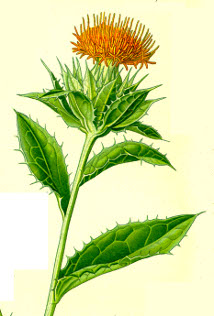 Carthamus tinctorius
Carthamus tinctoriusSafflower
This magic herb is an excellent example of Mars planetary influence
in plants: it has spines, the color of its flowers are reddish orange,
the flowers contain the planetary metal (iron), and it has an effect
on the blood (in traditional Chinese medicine, the petals are considered
a blood regulator). Perhaps as a tribute to the typical male energy
of Mars, in India, gay men smudge themselves with the smoke of safflower
petals before going out for the evening. Also in that country,
the female relatives of a would-be bride and groom dye the bride's
sheets and their own with safflower petals; a brilliant resulting
color indicates a marriage that will be successful. Safflower
is a good selection for a plant to offer ritual protection of your
property and to provide coloring for ritual (or non-ritual) purposes,
be it for foods (the Hope dyed their ceremonial wafer bread yellow
with safflower petals), textiles, or even skin (in various cultures, saffon petals have been processed into a makeup).
The ancient Egyptians grew safflower and used its dye to color fabric,
to anoint mummies before wrapping and to color the ritual ointments
used on statues of the gods; the flowers were woven into wreaths
for mummies (consider using dried flowers for this). In
Japan, the petals were prized as a silk dye (they make a very "unnatural"
pink on silk!). Regarding
the use of safflower as a dye, we found an interesting aside about
the ingredients Medea put into a spell; they included safflower,
saffron, alum, alkanet, blue vitriol, and others. People who do
dyework would recognize these as dye ingredients. Dyeing, as a transformative
art, is not far from magic, and some of the original secrets of
alchemy are in fact recipes for dyes and colorings for metals. Saffron
is especially magical, since the difference between acid and base
solution is the difference between yellow and red with these petals. Typical
ratio of dried petals to dry fiber is 1:1 for red, 2:1 for rose
pink, and 4:1 for pale pink. In Europe, safflower's coloring properties
have mostly been used for foods like cheese and sausage, in Afghanistan,
the petals are made into a tea for preventing miscarriage and infertility,
and in India, it is considered an aphrodisiac. Kohl was once made
of charred safflower. The petals are nice for coloring not only
rice, but pickles, sauces, and breads; they add no taste of their
own. Also
known as false saffron, dyer's saffron, bastard saffron, and Mexican saffron. We encourage you to save seeds
from this plant and grow it if you can. Just watch out for those
thorns. Top
How to Grow Safflower
Germinates in 10-24 days at cool room temperature (65F/18C). Start indoors under
lights 4-6 weeks before your last frost, or sow outside in spring
after the last frost, covering the seed lightly. Grow 6-9"/15-23cm
apart in full sun unless your summers get very hot, as in the south,
in which case give shade in the afternoon. This plant likes
deep, fertile soil and gets 24-36"/60-90cm tall. Safflower provides
nice cut flowers. It's also easy to air-dry opened flowers. For
dyeing, gather petals (watch your fingers) every 2-3 days just after dusk or before sunrise
and let them dry, then store in darkness in a jar until you have
enough for dyeing.
General
growing info
Extracting dye from safflowers:
Put the petals in a cloth bag or tie up in a piece of muslin. Cover with a mildly acid solution of one cup white vinegar to every gallon of water and let soak overnight. Squeeze out all the yellow; the yellow fluid can be used separately to color wool, silk, or cotton. Rinse the petals in water until all the yellow is gone. Cover with water and add either 1 tablespoon washing soda or ammonia per gallon of water. Soak a few hours, then squeeze out the bag and throw out the exhausted flowers. Add some vinegar to turn the water bright red. Put the fibers in and let sit in the sun for an afternoon. Remove the fibers and let them soak in a 1:1 solution of white vinegar and water for a half hour to set the dye. Rinse and dry. This dye is not lightfast and will gradually fade. But it sure is pretty! Top
Carthamus tinctorius
Corrales Safflower
20 seeds $4.00
Other dye Plants:
Indigo
Woad
Weld
Dyer's
Chamomile
Dyer's Broom
Dyer's
coreopsis
Uses in Witchcraft & Magic:
Ritual Dyes and Colorants
Protection
Mars Herb
© 2010-2024 Alchemy Works; No reproduction without permission